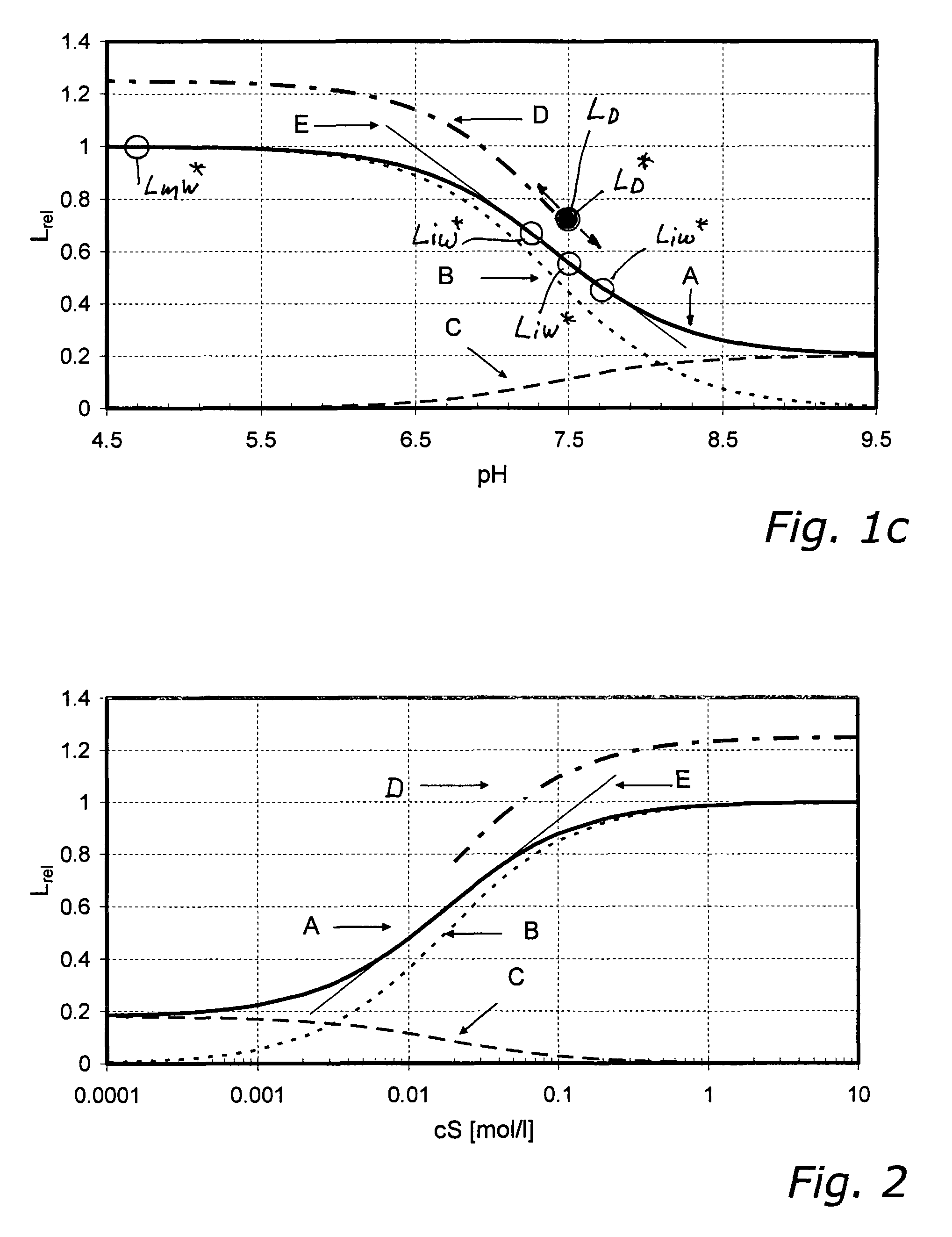Method for the determination of the concentration of a non-volatile analyte
a non-volatile analyte, concentration technology, applied in the direction of naphthalimide/phthalimide dye, optical radiation measurement, instruments, etc., can solve the problems of unsatisfactory plurality of fluids and other supplies, requiring expensive apparatus, and requiring time-consuming calibrating procedures involving various calibrating media prior to actual measuremen
- Summary
- Abstract
- Description
- Claims
- Application Information
AI Technical Summary
Benefits of technology
Problems solved by technology
Method used
Image
Examples
example 1
(With Sub-Variants 1.1 (FIG. 1a), 1.2 (FIG. 1b), and 1.3 (FIG. 1c) Using Equations 1 to 10)
[0213]In FIGS. 1a to 1c, which illustrate the sub-variants 1.1, 1.2 and 1.3 described in the following, the luminescence intensities scaled to LmW=1 of the individual species of a pH sensor (i.e., with H+ being the non-volatile analyte) are shown as functions of pH-value. Curve A represents the relative characteristic and is the sum of the luminescence intensities LAW and LBW of the individual species A and B. It was obtained from equation 10, with the value 7.4 used for parameter pK and the value 0.2 used for the parameter q, and equation 10 divided by LmW. The ratio between lowest intensity (right side) and highest intensity (left side) is the value of the parameter q. Curve B is the relative luminescence intensity of species B as a function of pH-value. Curve C is the relative luminescence intensity of species A as a function of pH-value. From curves B and C it can be seen that for pH9.5 es...
example 2
(With Subvariants 2.1 and 2.2 Not Using Equations 1 to 10)
[0272]It is an advantage of theoretically derived functional equations for the sensor characteristic that they usually describe the shape of the characteristic curve over the whole range of measurable analyte concentrations with sufficient accuracy. But for the purpose of dry calibration according to the invention it is not absolutely necessary to use the above, theoretically derived equations.
[0273]In principle alternative functional relationships may be used. The shape of the characteristic curve—at least over the expected range of the analyte concentration—can be represented sufficiently accurately, for instance by polynomials of first or second degree, by logarithmic functions, by rational functions or by combinations of these functions (e.g. LW=a+b·cS, LW=a+b·log(cS), LW=a+b·cS+c·(cS)2, or LW=a+b·pH, LW=a+b·log(pH), LW=a+b·pH+c·(pH)2). The functions cited as examples differ from the theoretically derived functions (e.g. ...
example 2.1
[0287]In a preferred variant of the method according to the invention a representative number of dry sensors S0 is selected from a plurality of sensors Sn made in the same way and the luminescence intensity LD* is measured without the use of an aqueous calibrating medium. Subsequently each of the sensors S0 is brought into contact with a number n of aqueous calibrating media with known concentrations cSi of the analyte, which are distributed at least over the expected range of the concentration to be measured, and n luminescence intensities (LiW*; i=1 . . . n) are measured, yielding n data pairs (cSiW*, LiW*; i=1 . . . n).
[0288]A suitable function of general form LW*=f(P1*, . . . , Pn*, cS or pH) (e.g. LW*=P1*+P2*·cS or LW*=P1*+P2*·pH) describing the shape of the sensor characteristic is fitted to the n data pairs, resulting—at least for part of the range of the analyte concentrations to be measured—in values for the parameters P1*, . . . , Pn* of an effective sensor characteristic ...
PUM
| Property | Measurement | Unit |
|---|---|---|
| activity coefficient | aaaaa | aaaaa |
| pH | aaaaa | aaaaa |
| thickness | aaaaa | aaaaa |
Abstract
Description
Claims
Application Information
 Login to View More
Login to View More - R&D
- Intellectual Property
- Life Sciences
- Materials
- Tech Scout
- Unparalleled Data Quality
- Higher Quality Content
- 60% Fewer Hallucinations
Browse by: Latest US Patents, China's latest patents, Technical Efficacy Thesaurus, Application Domain, Technology Topic, Popular Technical Reports.
© 2025 PatSnap. All rights reserved.Legal|Privacy policy|Modern Slavery Act Transparency Statement|Sitemap|About US| Contact US: help@patsnap.com



